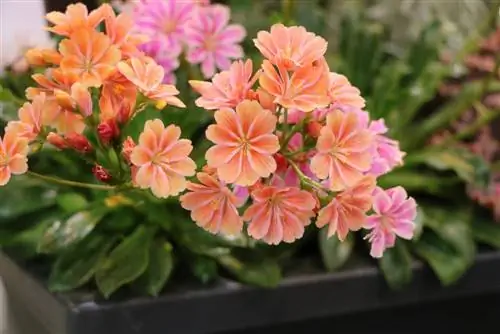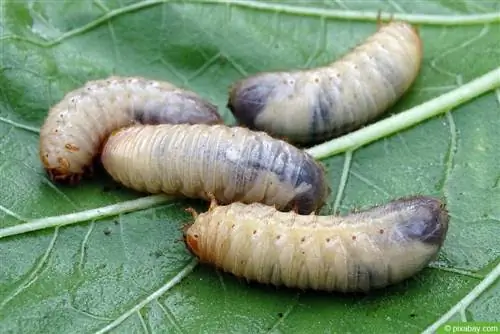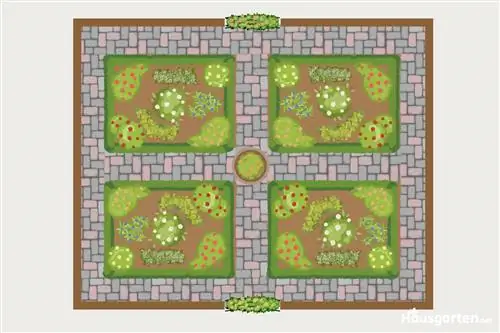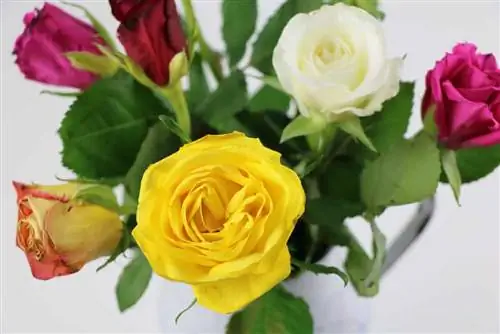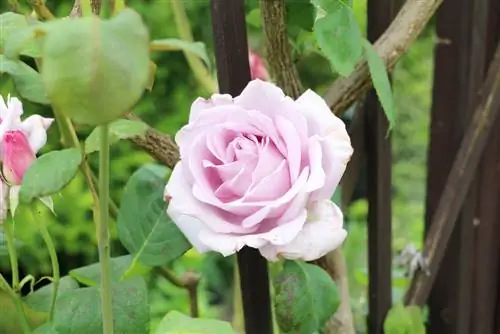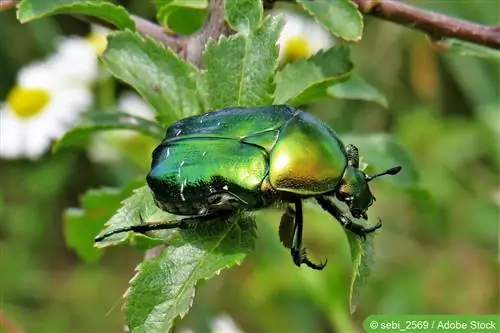- Author admin [email protected].
- Public 2023-12-17 03:39.
- Last modified 2025-06-01 06:48.
Gardeners interested in languages are still amused by the starkly contrasting names, while rock garden designers have long been decorating with the “blooming stars” - quite large areas, because the porcelain florets come in a wide variety of tones from white to yellow and orange, red, pink to the bluish range are offered. A clever combination results in an orgy of colors that blooms for a long time and requires little care:
Profile
- Lewisia cotyledon's full name is “common bitterroot”
- It belongs to the order of carnations (such as carnations, cacti, knotweed and 32 other plant families)
- The spring herb family, whose other 14 genera contain relatively unknown plants
- The genus Bitterroot (Lewisia) itself includes 17 species
- All of which are native to the mountainous western United States, Canada and Alaska
- The “common bitterroot” comes from the southwest of the USA
- Where it grows almost exclusively on rocky ground, in which the roots make their way through the cracks in the rock
- The rocky ground is usually in a coastal mountain range, where any excess moisture “can run off for miles”
- The soil and its composition therefore play a major role in Lewisia culture
Sowing, plants, choice of location
The common bitterroot is not one of the “sky-stormers”, even if individual cultivars stretch strongly upwards. But the original's specification - flower stalks on/off a basal rosette with its leaves spread flat on the ground - sets limits; No Lewisia cotyledon has ever achieved height growth of more than 40 cm.
The leaves are succulent and evergreen, look pretty as a rosette anyway and, in some variants/cultivars, also look really distinctive as a single leaf. However, the flowers are responsible for the actual show effects, which gave the natural species the name Porcelain Roses.
The small bitterroot needs an isolated location on the ground or an elevated location in a terraced rock garden. If possible, at the front of the bed or on the edge of the surrounding wall so that the flowers can be shown to their best advantage. There she can then show why she was given the “pet name” Porcelain Rose, and she likes to do that from May to July. Depending on the variety, with racemose inflorescences between 10 and 30 cm high, which bear up to 50 small flowers close together.
The interesting thing about the flower is the petals, their color varies even in the natural species: Most porcelain florets develop pink to purple petals with light and/or dark stripes, but there are always “creative plant individuals” in between “, which form white, cream-colored, yellow or orange petals, with yellow-orange to reddish stripes.
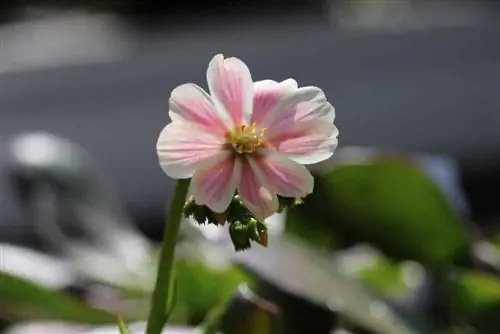
The soil for these “color miracles” should be as similar to the native soil as possible. In this case, the native soil is on a rocky slope in southwestern Oregon or northwestern California, and the soil in the rock garden is pretty close. A natural stone wall that can be planted is also a good place for porcelain roses, and the taller cultivars can also be planted in garden beds if the soil is very well-drained.
Overall, it is important that the long, fleshy taproot finds enough loose soil to make its way into the depths, so in a rock garden/natural stone wall there must be enough soil mass between the stones. Waterlogging quickly causes problems for the porcelain rose and causes the root collar to rot, so bitterroot garden soil in the bed will only like it if it is exceptionally well drained. Heavy, compacted soils cannot be tolerated in the long term; sufficient coarse sand or gravel should be incorporated here.
The pH values can range from normal to slightly acidic; soil that is too calcareous is not tolerated well by the Lewisias. Although the “dream soil of the Lewisias” is interspersed with sand and stones, there should also be areas of soil with a relatively high amount of humus and nutrients, as only these provide a good source of nutrition for bitter roots.
The light requirements are not that extreme, partial shade is sufficient for the original species, while multi-colored flower wonders such as L. cotyledon 'Sunset Strain' develop more splendor with a little more sunlight. Most evergreen Lewisias prefer partial shade to (too) full sun; in the Rocky Mountains they grow in rock faces facing east.
If there is a chance to plant porcelain roses in the sun and at the same time protected from the rain all year round, e.g. under an eaves, you should definitely take advantage of this opportunity - the less water from above, the better. If roofing is not possible, the next best solution is to plant the bitterroot under the shelter of a taller plant that is in the north-west direction (normal rain direction) of it.
Tip:
Porcelain florets in a pot should be repotted immediately after purchase or placed in the garden soil. Lewisia cotyledon hybrids, which are mass-produced from the garden center/hardware store, are usually grown in pure peat substrate. With regard to the lime content, this is not wrong, but peat substrate does not even begin to provide the moisture balance that porcelain florets need, but instead exposes the bitterroot to constant moisture around the root neck after every watering, which it cannot tolerate for long. So get out of the pot, either into the appropriately prepared garden area or, in the case of porcelain roses for pot cultivation, remove the top two thirds of the peat completely and replace it with coarse granite chippings. The lower third of the root ball in the pot can be left untouched if there is drainage and drainage beneath the roots.
Lewisias can also be sown well, you just need to be sure that the cold germinator seeds have been stratified or keep them in the fridge for a while to break dormancy. The sown seeds germinate reliably and are said to react very positively to germination accelerators with the plant hormone gibberellic acid.
Care instructions
The small perennial can be planted from April, the recommended planting distance for normal Lewisia cotyledon is 20 cm, strong-growing cultivars can be planted a little more generously, both are best planted in groups.
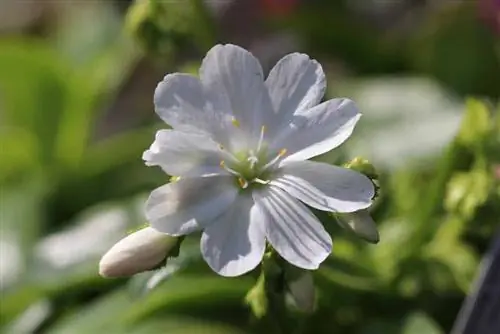
Pay attention to the moisture until it grows; Once the porcelain rose has taken root, it will usually grow happily without any care. Keeping away too much water (which can only be done by properly preparing the site) is much more important than adding water. You only really need to water additionally when it has been dry for quite a long time. At some point you will notice that the succulent's water reserves are running low and it will soon "run out".
Winter wetness is the peculiarity of our climate, which has probably killed most of the Lewisias that did not overwinter successfully in Germany. If the bitterroot does not grow under a roof and no roof can be installed for the winter, the first step you can take is to lay down a really good layer of gravel or grit or loose small stones and then observe whether rainwater drains off quickly enough to protect the root neck To protect against rot.
If this is difficult to observe in the given location or is doubtful (and you have perhaps already reached rare collector's varieties of Lewisia, see below), you can ensure that your bitterroot overwinteres safely by planting it in pots and place under a roof over the winter (a parapet, a wall eaves, a wide window sill under an eaves).
As a rule, you don't need to worry about frost hardiness, bitterroot is considered to be extremely frost hardy and is designated as hardiness zone 7 (=tolerates climates in which winter temperatures fall on average to -18 °C).
You can propagate your porcelain florets by rooted leaf or twig cuttings, by lowering daughter rosettes or by seeds. Self-collected cold germinator seeds must go through a cold period before sowing; Either sow again in the fall or store the seeds in the refrigerator until spring. The young plants should be protected as well as possible from snails, which have a great appetite for the succulent plant parts of the bitterroot.
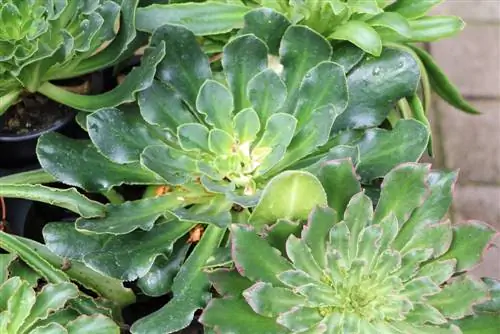
You can choose whether the bitterroot is suitable for cultivation as a houseplant: According to Wikipedia (de.wikipedia.org/wiki/Gewöhnliche_Bitterwurz) Lewisia cotyledon does not thrive in indoor culture, at www.samen-seeds.de/Stauden/L-N/Lewisia-Bitterwurz-Lewisie/Lewisia-cotyledon-Sunset-Strain-Lewisie-Bitterwurz-Samen.html the L. cotyledon 'Sunset Strain' is recommended for cultivation in "planters of all kinds", according to de.hortipedia.com/wiki/Lewisia_cotyledon the "perennial with lover value" can also be cultivated as a container plant and potted plant. An image search reveals a considerable number of Lewisias in pots or balcony boxes, so in principle the plant cannot be averse to the principle of pot culture. Wikipedia probably means “indoor culture in the narrower sense”, plant culture in pots and only in the room, while you have a good chance with porcelain roses grown in pots (sometimes in the room, outside as often as possible). Just don't forget to water sunny bitterroot in winter as soon as the temperatures are well into the plus range.
Varieties, cultivars, more porcelain florets
Lewisia cotyledon has developed into three varieties, Lewisia cotyledon var
1. Lewisia cotyledon 'Alba' has naturally white flowers
2. Lewisia cotyledon 'Blue Purple' sometimes only creates pink, but sometimes also a clear blue tint: nwwildflowers.files.wordpress.com/2011/03/img_0429lewisia.jpg
3. Lewisia cotyledon 'Elise' was bred by the Dutch company Floragran, which won the "Fleuro-Star Award" for it in 2012. No wonder, Elise shows a whole firework of colors. Elise is a warm germinator that is so easy to grow that it can be used e.g. B. can be cultivated as an annual on the balcony. Prefer at 20 to 22 degrees in the room or in the greenhouse. Elise will bloom five to six months after sowing, and if sowed accurately, from early spring to autumn.
4. Lewisia cotyledon 'Praline' is no less beautiful and no less colorful, but gentler, the 'Elise' for romantics
5. L. cotyledon 'Rainbow' was one of the exciting new releases in 1990, probably the first bitterroot to be 'colorful'. The simple to semi-double flowers, which are striking in their quantity, choose a color family as a theme, here the whole range from red to blue
6. Lewisia cotyledon 'Sunset Strain' develops all the red tones in the world on fairly long flower stalks, close together and with white accents
7. Lewisia cotyledon 'White Splendor' does not surpass 'Alba' in the abundance of flowers, but in the splendor and charisma of the individual flowers
Tip:
If you cannot provide porcelain roses with dry areas/rock gardens, you could plant the original natural species instead of the modern hybrids. They are sold in all three versions, although certainly not in the nearest hardware store oras a mass-produced product at all, but rather from specialized nurseries. In a forum post, a gardener with 40 years of experience with Lewisias reports on a robust, waterproof, indestructible variety with differently shaped rosettes and exclusively pink/white striped flowers and is annoyed that he later watered down their good genetic material with hardware store plants such as Sunset Strain and others. This robust Lewisia could be the Lewisia cotyledon var. howellii, which also grows in forests in nature. Peppermint flowers in white-pink and oddly shaped rosettes are definitely in the photo wildgingerfarm.com/plant-list/plants -l/lewisia-cotyledon-var-howel.html (the other natural forms are also said to be quite robust).
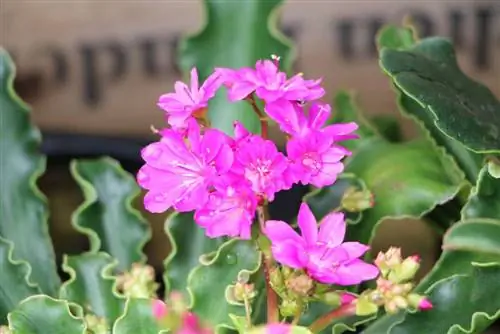
Nature is wasteful and extremely creative, which is why 17 Lewisias have developed in the North American distribution area of the genus, which are different enough to be classified as a species. Most of them are cultivated including plants with funny peculiarities like the Lewisia brachycalyx, which goes completely in after flowering and then produces more flowers every year in the next season. The Lewisia columbiana, which forms small cushions, is considered to be insensitive to moisture, but also not to be shocked by bright sunshine; Cushions in several soft and brightly colored varieties such as 'Little Mango', 'Little Peach', 'Little Plum' developed Lewisia longipetala; Lewisia rediviva is the only Lewisia that tolerates calcareous substrate.
You can get these Lewisias and others in the above-mentioned specialist nurseries, but also through societies or associations of cactus and succulent lovers such as the German Cactus Society e. V. (www.dkg.eu) or the Specialist Society for Other Succulents e. V. (www. fgas-sukkulenten.de).
Tip:
If you are missing explanations about the healing power of Lewisias: Indians are said to have used certain types of bitterroot for medicinal purposes (and cooked and eaten the roots, but little is known about this in our culture; no one here heals with Lewisias, and Nobody has probably eaten their roots yet. The bitter root you are thinking of (if you are missing explanations about the healing power) belongs to the yellow gentian “Gentiana lutea”, a bitter root or fever root that has been known and used for a long time.

